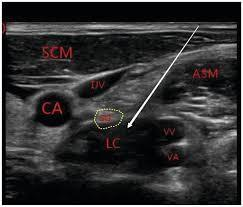A Stellate ganglion block is more complex than other nerve injections
1. Ultrasound guidance is a must!
Stellate gangion procedural ultrasound of the neck

Any job is easier with the right tools! In regards to stelate ganglion blocks, ultrasound guidance is a must. If your not sure what ultrasound is, imagine being able to see all the critical anatomy (eg, vertebral artery, internal carotid artery, inferior thyroid artery, and spinal nerves) before you start a procedure. That’s what ultrasound can do – all the above anatomy can be visualized and avoided with some pre-procedure planning. With Color flow, even small blood vessels can be seen. If your provider isn’t comfortable with ultrasound – keep looking! No sense wasting time if they can’t get past step 1
Any job is easier with the right tools! In regards to stelate ganglion blocks, ultrasound guidance is a must. If your not sure what ultrasound is, imagine being able to see all the critical anatomy (eg, vertebral artery, internal carotid artery, inferior thyroid artery, and spinal nerves) before you start a procedure. That’s what ultrasound can do – all the above anatomy can be visualized and avoided with some pre-procedure planning. With Color flow, even small blood vessels can be seen. If your provider isn’t comfortable with ultrasound – keep looking! No sense wasting time if they can’t get past step 1
Stellate gangion procedural ultrasound of the neck

CA is Carotid artery, LC is Longissimus coli, IJV is internal jugular veini. The circle is the location of the stellate ganglion.
CA is Carotid artery, LC is Longissimus coli, IJV is internal jugular vein. The circle is the location of the stellate ganglion.
2. Ask if their willing to consider bilateral injection on the same day. If they are – don’t call them back!
Sure you could save time for a patient and maybe save them an extra trip to the office if another injection is needed. Careful – neuroanatomy doesn’t care about good intentions! Only 1 side should be done at a time. If a provider is willing to perform bilateral stellate ganglion blocks, they may have good intentions, but the risk is significantly higher.
Why? Though rare, if local anesthetic spreads to the recurrent laryngeal nerve, the result is a temporary vocal cord paralysis. We each have two vocal cords that protect our airway. If both sides are compromised, advanced airway skills are needed to protect you from potentially aspirating until the local anesthetic wears off (could be hours!).
Sure you could save time for a patient and maybe save them an extra trip to the office if another injection is needed. Careful – neuroanatomy doesn’t care about good intentions! Only 1 side should be done at a time. If a provider is willing to perform bilateral stellate ganglion blocks, they may have good intentions, but the risk is significantly higher.
Why? Though rare, if local anesthetic spreads to the recurrent laryngeal nerve, the result is a temporary vocal cord paralysis. We each have two vocal cords that protect our airway. If both sides are compromised, advanced airway skills are needed to protect you from potentially aspirating until the local anesthetic wears off (could be hours!).
3. Do you understand what a Horner's syndrome is?
At Libertas Mind we make sure patients are informed. Due dilligence and informed consent don’t mean the same thing to all providers. A SGB has tremendous physiological impact and one of the few procedures we document success by causing an intentional side effect. If done correctly, a SGB lead’s to temporary Horner’s syndrome.
Horner syndrome (Horner’s syndrome or oculosympathetic paresis) results from an interruption of the sympathetic nerve supply to the eye and is characterized by the classic triad of miosis (ie, constricted pupil), partial ptosis, and loss of hemifacial sweating (ie, anhidrosis), as well as enophthalmos (sinking of the eyeball into the bony cavity that protects the eye).
At Libertas Mind we make sure patients are informed. Due dilligence and informed consent don’t mean the same thing to all providers. A SGB has tremendous physiological impact and one of the few procedures we document success by causing an intentional side effect. If done correctly, a SGB lead’s to temporary Horner’s syndrome.
Horner syndrome (Horner’s syndrome or oculosympathetic paresis) results from an interruption of the sympathetic nerve supply to the eye and is characterized by the classic triad of miosis (ie, constricted pupil), partial ptosis, and loss of hemifacial sweating (ie, anhidrosis), as well as enophthalmos (sinking of the eyeball into the bony cavity that protects the eye).
4. What equipment should be there to assure your safety?
Safety is built on redundancy. While complications from SGB are rare, a pre procedure IV should be started. Your vital signs should be monitored during the procedure. Simple enough but judging from the many videos posted online of SGB’s, many providers have forgot this!
Safety is built on redundancy. While complications from SGB are rare, a pre procedure IV should be started. Your vital signs should be monitored during the procedure. Simple enough but judging from the many videos posted online of SGB’s, many providers have forgot this!
5. What makes a physician qualified to perform a Stellate ganglion block?
The procedure has been around for approximately 100 years and is typically performed by an anesthesiologist or specialist in peripheral nerve injections. Some anesthesiologists perform hundreds of nerve injections during their career, while pain specialists may perform thousands.
The procedure has been around for approximately 100 years and is typically performed by an anesthesiologist or specialist in peripheral nerve injections. Some anesthesiologists perform hundreds of nerve injections during their career, while pain specialists may perform thousands.
I'm sure this post will help you on your way to wellness. Seek out the most qualified provider to help you. Any questions, contact us at Libertas Mind.
About Dr. Steindler and Libertas Mind
Dr. Steinder is a double board certified phsyician in pain medicine, and anesthesiology – and one of small number of phsicians offering stellate ganglion blocks for PTSD. Interventional pain physicians are the only doctors specifically trained in stellate ganglion injections during their training. He is also an assistant professor and teaches other physician’s how to perform this procedure. Learn more about the experts at Libertas Mind, Stellate ganglion blocks as a treatment for PTSD, or contact us for more information.
Dr. Steinder is a double board certified phsyician in pain medicine, and anesthesiology – and one of small number of phsicians offering stellate ganglion blocks for PTSD. Interventional pain physicians are the only doctors specifically trained in stellate ganglion injections during their training. He is also an assistant professor and teaches other physician’s how to perform this procedure. Learn more about the experts at Libertas Mind, Stellate ganglion blocks as a treatment for PTSD, or contact us for more information.


